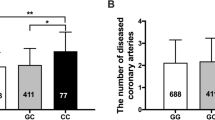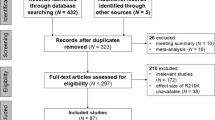Abstract
Interleukin 6 receptor (IL-6R), mediating IL-6’s biological functions, plays an important role in different diseases such as diabetes, obesity and cardio-vascular diseases. In this study, we investigated the effects of two single nucleotide polymorphisms (SNPs), within the IL-6R loci, previously associated with C-reactive protein (CRP) and coronary heart diseases risk, and with controversial effects on lipids traits: SNP rs4845625 and SNP rs4537545. The results showed that both investigated SNPs were antagonistically related with CRP levels; the minor rs4845625*T allele was associated with increased CRP levels (P-value=0.011), while the minor rs4537545*T allele was associated with decreased CRP levels (P-value=0.009). Interestingly, the minor rs4845625*T allele was significantly associated with higher low-density lipoprotein cholesterol (LDL-C) and ApoB levels (P=0.007 and P=0.009 respectively). Haplotype analysis showed that the TC haplotype, having the minor rs4845625*T allele, was related simultaneously with increased levels of CRP, LDL-C and ApoB levels, thus could be considered as a risk factor. Our investigation detects for the first time an independent effect of rs4845625 on LDL-C and ApoB traits, explaining an important range of those traits variability (3.49 and 5.57% respectively). Our findings might be of high clinical significance in pharmacogenomics studies of tocilizumab for which IL-6R is target.
This is a preview of subscription content, access via your institution
Access options
Subscribe to this journal
Receive 6 digital issues and online access to articles
$119.00 per year
only $19.83 per issue
Buy this article
- Purchase on Springer Link
- Instant access to full article PDF
Prices may be subject to local taxes which are calculated during checkout


Similar content being viewed by others
References
Heinrich PC, Behrmann I, Muller-Newen G, Schaper F, Graeve L . Interleukin-6-type cytokine signalling through the gp130/Jak/STAT pathway. Biochem J 1998; 334 (Pt 2): 297–314.
Horiuchi S, Koyanagi Y, Zhou Y, Miyamoto H, Tanaka Y, Waki M et al. Soluble interleukin-6 receptors released from T cell or granulocyte/macrophage cell lines and human peripheral blood mononuclear cells are generated through an alternative splicing mechanism. Eur J Immunol 1994; 24: 1945–1948.
Matthews V, Schuster B, Schutze S, Bussmeyer I, Ludwig A, Hundhausen C et al. Cellular cholesterol depletion triggers shedding of the human interleukin-6 receptor by ADAM10 and ADAM17 (TACE). J Biol Chem 2003; 278: 38829–38839.
Esteve E, Villuendas G, Mallolas J, Vendrell J, Lopez-Bermejo A, Rodriguez M et al. Polymorphisms in the interleukin-6 receptor gene are associated with body mass index and with characteristics of the metabolic syndrome. Clin Endocrinol (Oxf) 2006; 65: 88–91.
Consortium CAD Consortium CAD Deloukas P Consortium CAD Kanoni S Consortium CAD Willenborg C Consortium CAD Farrall M Consortium CAD Assimes TL et al. Large-scale association analysis identifies new risk loci for coronary artery disease. Nat Genet 2013; 45: 25–33.
Wolford JK, Colligan PB, Gruber JD, Bogardus C . Variants in the interleukin 6 receptor gene are associated with obesity in Pima Indians. Mol Genet Metab 2003; 80: 338–343.
Wang H, Zhang Z, Chu W, Hale T, Cooper JJ, Elbein SC . Molecular screening and association analyses of the interleukin 6 receptor gene variants with type 2 diabetes, diabetic nephropathy, and insulin sensitivity. J Clin Endocrinol Metab 2005; 90: 1123–1129.
Collaboration IRGCERF Collaboration IRGCERF Sarwar N Collaboration IRGCERF Butterworth AS Collaboration IRGCERF Freitag DF Collaboration IRGCERF Gregson J Collaboration IRGCERF Willeit P et al. Interleukin-6 receptor pathways in coronary heart disease: a collaborative meta-analysis of 82 studies. Lancet 2012; 379: 1205–1213.
Walston JD, Matteini AM, Nievergelt C, Lange LA, Fallin DM, Barzilai N et al. Inflammation and stress-related candidate genes, plasma interleukin-6 levels, and longevity in older adults. Exp Gerontol 2009; 44: 350–355.
Shah T, Zabaneh D, Gaunt T, Swerdlow DI, Shah S, Talmud PJ et al. Gene-centric analysis identifies variants associated with interleukin-6 levels and shared pathways with other inflammation markers. Circ Cardiovasc Genet 2013; 6: 163–170.
Elliott P, Chambers JC, Zhang W, Clarke R, Hopewell JC, Peden JF et al. Genetic Loci associated with C-reactive protein levels and risk of coronary heart disease. JAMA 2009; 302: 37–48.
Gigante B, Strawbridge RJ, Velasquez IM, Golabkesh Z, Silveira A, Goel A et al. Analysis of the role of interleukin 6 receptor haplotypes in the regulation of circulating levels of inflammatory biomarkers and risk of coronary heart disease. PLoS One 2015; 10: e0119980.
Abe S, Tokoro F, Matsuoka R, Arai M, Noda T, Watanabe S et al. Association of genetic variants with dyslipidemia. Mol Med Rep 2015; 12: 5429–5436.
Vargas VR, Bonatto SL, Macagnan FE, Feoli AM, Alho CS, Santos ND et al. Influence of the 48867A>C (Asp358Ala) IL6R polymorphism on response to a lifestyle modification intervention in individuals with metabolic syndrome. Genet Mol Res 2013; 12: 3983–3991.
Jiang CQ, Lam TH, Liu B, Lin JM, Yue XJ, Jin YL et al. Interleukin-6 receptor gene polymorphism modulates interleukin-6 levels and the metabolic syndrome: GBCS-CVD. Obesity (Silver Spring) 2010; 18: 1969–1974.
Yates A, Akanni W, Amode MR, Barrell D, Billis K, Carvalho-Silva D et al. Ensembl 2016. Nucleic Acids Res 2016; 44 (D1): D710–D716.
Varbo A, Benn M, Tybjaerg-Hansen A, Nordestgaard BG . Elevated remnant cholesterol causes both low-grade inflammation and ischemic heart disease, whereas elevated low-density lipoprotein cholesterol causes ischemic heart disease without inflammation. Circulation 2013; 128: 1298–1309.
Gotto AM Jr . Jeremiah Metzger Lecture: cholesterol, inflammation and atherosclerotic cardiovascular disease: is it all LDL? Trans Am Clin Climatol Assoc 2011; 122: 256–289.
Singh SK, Suresh MV, Voleti B, Agrawal A . The connection between C-reactive protein and atherosclerosis. Ann Med 2008; 40: 110–120.
Wu G, Cheng M, Huang H, Yang B, Jiang H, Huang C . A variant of IL6R is associated with the recurrence of atrial fibrillation after catheter ablation in a Chinese Han population. PLoS One 2014; 9: e99623.
Vargas JD, Manichaikul A, Wang XQ, Rich SS, Rotter JI, Post WS et al. Detailed analysis of association between common single nucleotide polymorphisms and subclinical atherosclerosis: The multi-ethnic study of atherosclerosis. Data Brief 2016; 7: 229–242.
Chu NF, Lin FH, Chin HC, Hong YJ . Association between interleukin-6 receptor gene variations and atherosclerotic lipid profiles among young adolescents in Taiwan. Lipids Health Dis 2011; 10: 136.
Kinoshita S, Ogawa W, Okamoto Y, Takashima M, Inoue H, Matsuki Y et al. Role of hepatic STAT3 in the regulation of lipid metabolism. Kobe J Med Sci 2008; 54: E200–E208.
Cernkovich ER, Deng J, Bond MC, Combs TP, Harp JB . Adipose-specific disruption of signal transducer and activator of transcription 3 increases body weight and adiposity. Endocrinology 2008; 149: 1581–1590.
Nishimoto N, Kishimoto T . Humanized antihuman IL-6 receptor antibody, tocilizumab. Handb exp pharmacol 2008; 181: 151–160.
Al-Shakarchi I, Gullick NJ, Scott DL . Current perspectives on tocilizumab for the treatment of rheumatoid arthritis: a review. Patient Prefer Adherence 2013; 7: 653–666.
Kawashiri SY, Kawakami A, Yamasaki S, Imazato T, Iwamoto N, Fujikawa K et al. Effects of the anti-interleukin-6 receptor antibody, tocilizumab, on serum lipid levels in patients with rheumatoid arthritis. Rheumatol Int 2011; 31: 451–456.
Friedewald WT, Levy RI, Fredrickson DS . Estimation of the concentration of low-density lipoprotein cholesterol in plasma, without use of the preparative ultracentrifuge. Clin chem 1972; 18: 499–502.
Chen MH, Yang Q . GWAF: an R package for genome-wide association analyses with family data. Bioinformatics 2010; 26: 580–581.
Kleefstra T, Schenck A, Kramer JM, van Bokhoven H . The genetics of cognitive epigenetics. Neuropharmacology 2014; 80: 83–94.
Acknowledgements
The data used come from the BRC ‘Interactions Gène-Environnement en Physiopathologie CardioVasculaire’ in Nancy, France. The SFS was supported by the ‘Caisse Nationale d’Assurance Maladies des Travailleurs Salariés’, the ‘Institut National de la Santé et de la Recherche Médicale’ (INSERM), the ‘Région Lorraine’, the ‘Communauté Urbaine du Grand Nancy’ and the University of Lorraine. We are deeply grateful for the cooperation of the individuals participating in the study sample.
This work was supported by the University of Lorraine with a «Contrat de travail de droit public».
Weblinks
http://www.ncbi.nlm.nih.gov/projects/SNP/
http://www.lgcgroup.com/services/genotyping/#.VmQwfoR6GFI
https://analysistools.nci.nih.gov/LDlink/
http://snipa.helmholtz-muenchen.de/snipa
http://www.gtexportal.org/home/
Author information
Authors and Affiliations
Corresponding author
Ethics declarations
Competing interests
The authors declare no conflict of interest.
Additional information
Supplementary Information accompanies this paper on Genes and Immunity website
Supplementary information
Rights and permissions
About this article
Cite this article
Arguinano, A., Naderi, E., Ndiaye, N. et al. IL6R haplotype rs4845625*T/rs4537545*C is a risk factor for simultaneously high CRP, LDL and ApoB levels. Genes Immun 18, 163–169 (2017). https://doi.org/10.1038/gene.2017.16
Received:
Revised:
Accepted:
Published:
Issue Date:
DOI: https://doi.org/10.1038/gene.2017.16
This article is cited by
-
Impact of IL6R genetic variants on treatment efficacy and toxicity response to sarilumab in rheumatoid arthritis
Arthritis Research & Therapy (2023)



